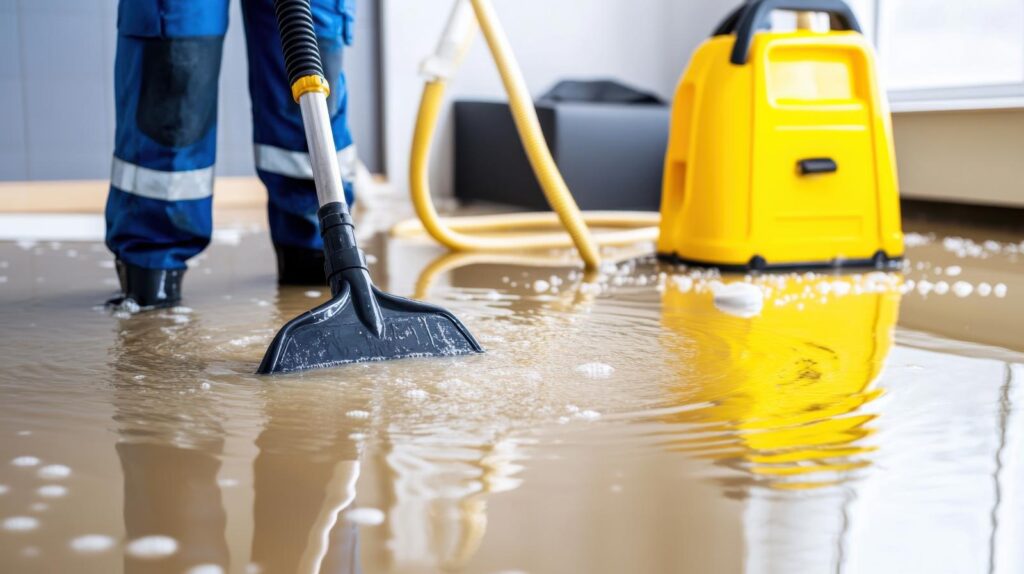
Contents
Did you know that improper water extraction can lead to up to 40% more damage in affected areas? Selecting the right tools is essential for effective mitigation. You need to assess the water intrusion first, as different methods suit different situations. But how do you determine which equipment is best for your specific needs? Understanding the nuances of various tools can greatly impact your success in water extraction.
Key Takeaways
- Assess the extent of water damage to determine the appropriate extraction method, whether it’s vacuum extraction or submersible pumps.
- Choose equipment with a pump capacity of 50-100 gallons per hour for efficient water removal.
- Prioritize lightweight and compact tools for better maneuverability in tight spaces during extraction operations.
- Evaluate the durability and power efficiency of tools to ensure long-term performance and lower operational costs.
- Consider budget implications, including initial costs and maintenance needs, when selecting water extraction equipment.
Assessing the Type and Extent of Water Damage
How can you accurately assess the type and extent of water damage in a property?
Start by visually inspecting the affected areas. Look for discoloration, warping, or peeling paint—these signs indicate moisture presence.
Next, check for standing water, which can signal severe damage. Use a moisture meter to quantify the water content in materials like drywall or wood; readings above 15% usually suggest significant intrusion.
Consider the source of the water. Is it clean, gray, or black water? Each category impacts the assessment and necessary response.
Document your findings with photos and notes for reference. Additionally, assess underlying structures, such as insulation and flooring, as they may harbor hidden damage.
Understanding Different Water Extraction Methods
Once you’ve assessed the type and extent of water damage, it’s time to evaluate the various water extraction methods available.
You’ll typically encounter three primary techniques: vacuum extraction, submersible pumps, and truck-mounted systems.
Vacuum extraction is effective for small to moderate spills, using high-suction vacuums to draw water quickly from carpets and floors.
For deeper water or flooded areas, submersible pumps come into play, designed to remove large volumes of water efficiently. These pumps can handle significant depths, making them ideal for basements or flooded spaces.
Truck-mounted systems offer a robust solution for extensive damages, combining powerful pumps and heating elements for both extraction and drying.
Each method has its specific application, and understanding them guarantees you choose the right one for your situation.
Evaluating Equipment Specifications and Features
When selecting equipment for water extraction, what specific specifications and features should you prioritize to guarantee peak performance? First, consider the pump capacity, as it directly impacts the volume of water you can extract per hour. Next, focus on the power source and efficiency, making sure it meets your operational needs without excessive energy consumption. Finally, check the build quality and durability, especially if you’ll be using the equipment in demanding environments.
| Feature | Importance | Ideal Specification |
|---|---|---|
| Pump Capacity | Affects extraction speed | 50-100 gallons per hour |
| Power Efficiency | Reduces operational costs | 80% or higher |
| Durability | Ensures longevity in harsh conditions | Heavy-duty materials |
Considering Portability and Ease of Use
When selecting water extraction tools, you’ll want to prioritize weight and size to guarantee easy transport and maneuverability.
Consider user-friendly features that enhance operation efficiency, especially in challenging environments.
Evaluating these aspects will help you choose equipment that meets your needs without unnecessary strain.
Weight and Size
Choosing the right tools for water extraction hinges considerably on their weight and size, especially if you need to transport them frequently.
Lightweight tools are easier to maneuver and carry, reducing fatigue during extended use. Consider the dimensions of the equipment; compact models fit easily into tight spaces and simplify storage.
When evaluating weight, look for robust materials that don’t compromise durability. A balance between sturdiness and portability is crucial, ensuring you can handle the tools efficiently without sacrificing performance.
Additionally, think about how the size affects accessibility in various environments. Ultimately, selecting equipment that aligns with your physical capabilities and operational needs fosters a sense of belonging to a community of skilled water extraction professionals.
User-Friendly Features
What features enhance usability in water extraction tools? When you’re choosing equipment, you want tools that simplify your tasks and increase efficiency.
Look for user-friendly features that prioritize portability and ease of use. Here are some key attributes to take into account:
Lightweight Design: Tools that are easy to carry reduce fatigue and allow for quick deployment in emergency situations.
Intuitive Controls: Simple, clearly labeled buttons and dials let you operate your tool without extensive training, saving time and minimizing errors.
Compact Storage: Tools that fold or disassemble easily can be stored in tight spaces, making them accessible whenever you need them.
Budgeting for Water Extraction Tools
Budgeting for water extraction tools requires careful consideration of various factors to guarantee you allocate resources effectively.
Start by evaluating your specific needs based on the scale of your operation. Identify the types of water extraction tools required, such as pumps, vacuums, or dehumidifiers, and research their costs. Factor in both initial purchase prices and potential long-term expenses, like repairs or upgrades.
Next, prioritize quality over quantity; investing in reliable tools can save you money on replacements and improve efficiency.
Consider whether you’ll need additional accessories or consumables, which can add to your total expenditure.
Finally, don’t overlook potential financing options or bulk purchase discounts that can ease the financial strain.
Maintenance and Care for Water Extraction Equipment
Once you’ve invested in quality water extraction tools, maintaining and caring for them is essential to assure longevity and peak performance.
Regular upkeep not only enhances efficiency but also guarantees safety during operation. Here are key maintenance practices to follow:
Clean Thoroughly: After each use, remove debris and residue from your equipment to prevent clogs and corrosion.
Inspect Components: Regularly check hoses, filters, and seals for wear and tear. Replace damaged parts immediately to avoid costly repairs.
Store Properly: Keep your tools in a dry, temperature-controlled environment. Use protective cases or covers to shield them from dust and moisture.
Recap
In summary, selecting the right tools for water extraction is essential for effective damage control. Did you know that 98% of basements will experience some form of water damage in their lifetime? By understanding the extent of the damage and choosing appropriate equipment, you can minimize loss and guarantee a swift recovery. Prioritize high-quality, portable tools that suit your specific needs while staying within budget. Proper maintenance will extend your equipment’s lifespan, making it a wise investment.
Recent Posts
Choosing Genuine Water Extraction Tools for Restoration
When tackling water damage restoration, choosing genuine water extraction tools is essential for effective results.
3 Tips for Selecting Water Extraction Tools
Many people overlook the impact of water type on extraction tool selection, yet it’s vital
Why Choose the Right Water Extraction Tools?
Choosing the right water extraction tools is crucial for effective moisture management. Using appropriate equipment
